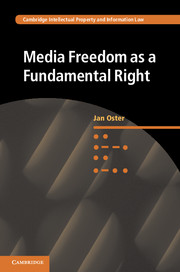Book contents
- Frontmatter
- Contents
- Preface and acknowledgements
- Table of cases
- Treaties, Conventions, Declarations and Statutes
- Reports and other documentary sources
- Introduction: aim, scope and method
- Part I The theoretical foundations of media freedom
- Part II General rules on media freedom
- Part III Specific limitations to media freedom
- 7 Personality rights and intellectual property as ‘rights of others’
- 8 Threats to public order interests: national security, territorial integrity, public safety and prevention of disorder and crime
- 9 The protection of health and morals
- 10 Maintaining the authority and impartiality of the judiciary
- 11 Incitement to hatred
- 12 Religiously offensive publications
- 13 Restrictions on commercial publications
- 14 Media pluralism
- Conclusion: tenets of a Media Freedom Principle
- Bibliography
- Index
- Cambridge Intellectual Property and Information Law
9 - The protection of health and morals
from Part III - Specific limitations to media freedom
Published online by Cambridge University Press: 05 June 2015
- Frontmatter
- Contents
- Preface and acknowledgements
- Table of cases
- Treaties, Conventions, Declarations and Statutes
- Reports and other documentary sources
- Introduction: aim, scope and method
- Part I The theoretical foundations of media freedom
- Part II General rules on media freedom
- Part III Specific limitations to media freedom
- 7 Personality rights and intellectual property as ‘rights of others’
- 8 Threats to public order interests: national security, territorial integrity, public safety and prevention of disorder and crime
- 9 The protection of health and morals
- 10 Maintaining the authority and impartiality of the judiciary
- 11 Incitement to hatred
- 12 Religiously offensive publications
- 13 Restrictions on commercial publications
- 14 Media pluralism
- Conclusion: tenets of a Media Freedom Principle
- Bibliography
- Index
- Cambridge Intellectual Property and Information Law
Summary
Article 19(3)(b) ICCPR, Article 10(2) ECHR and Article 13(2)(b) ACHR all provide that the exercise of freedom of expression may be subject to restrictions for the protection of, inter alia, health and morals. The African Charter states in Article 27(2) that the rights and freedoms of the Charter shall be exercised with due regard to, inter alia, morality. However, the AfCHPR does not provide a limitation on freedom of expression based on health. Since Articles 11 and 12(2) of the Charter include such a health clause, one could argue, argumentum e contrario, that restrictions on freedom of expression based on the protection of health are not permissible. In practice, it is nevertheless to be expected that the African Commission would base an interference with freedom of expression and media freedom pursuing public health rationales on the ‘common interest’ clause in Article 27(2) AfCHPR. Yet this example reveals another conceptual deficit of the freedom of expression provision in the African Charter.
‘Health’
The protection of ‘health’ as justification for an interference with freedom of expression and media freedom becomes relevant where a publication allegedly prompts harmful conduct. An interference to which the ‘health’ rationale applies is especially the regulation of advertising, for example, for harmful products, such as tobacco or alcohol, and of practitioners of medical professions. For example, in Women on Waves and others v. Portugal, the ECtHR held that the interference by the Portuguese authorities – the banning of the applicants’ ship from entering Portuguese territorial waters to prevent them from holding meetings on the prevention of sexually transmitted diseases, family planning and the decriminalisation of abortion – pursued the legitimate aim of protection of health.
‘Morals’
The consideration of ‘morals’ as civility rules limiting freedom of expression in Article 19(3) ICCPR, Article 13(2)(b) ACHR and Article 10(2) ECHR 4 is remarkable.
- Type
- Chapter
- Information
- Media Freedom as a Fundamental Right , pp. 212 - 218Publisher: Cambridge University PressPrint publication year: 2015

